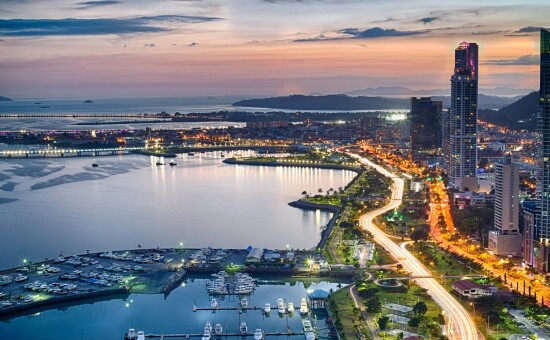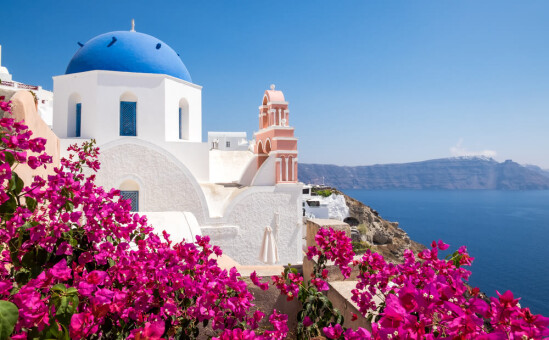Guide to the Iconic Cherry Blossom Season in Japan
It’s almost cherry blossom season in Japan! Keep reading for the best places to see these beautiful flowers in each region of the country.
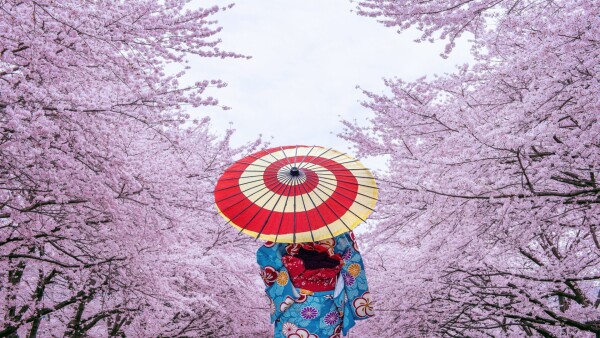
The Cherry Blossom Season in Japan is an iconic symbol of springtime.
Also known in Japanese as sakura, this particular time of the year sees the country covered in a beautiful blanket of multi-hued shades of pink. Seeing them in person feels like a real-life fairytale as you admire them from the riverside, amongst the gorgeous Japanese parks or from the pagodas of significant shrines.
With over 1,000 locations across the country to view these beautiful flowers, choosing where to go can be difficult. Especially as the sakura season only lasts for a short time.
That’s why you have to plan ahead.
Below we will detail some of the most stunning spots to visit by region.
Why is the Cherry Blossom Season Important?
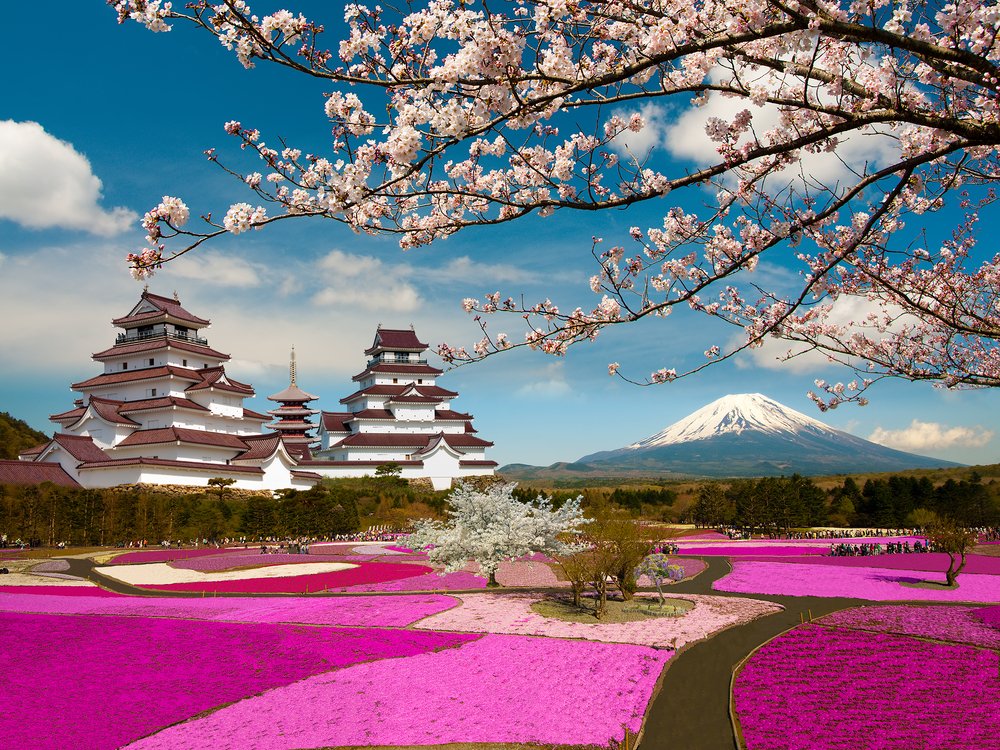
Cherry blossoms are a national symbol of Japan and have been celebrated for centuries.
For many Japanese, the short blooming of the cherry blossom trees symbolizes the nature of life and that nothing in the world is permanent. While sad, it’s about celebrating and valuing the limited time frame, with many enjoying flower-watching parties known as hanami. Some even get together at night for a picnic with pretty paper lanterns to heighten the experience.
When do Cherry Blossoms Bloom in Japan?
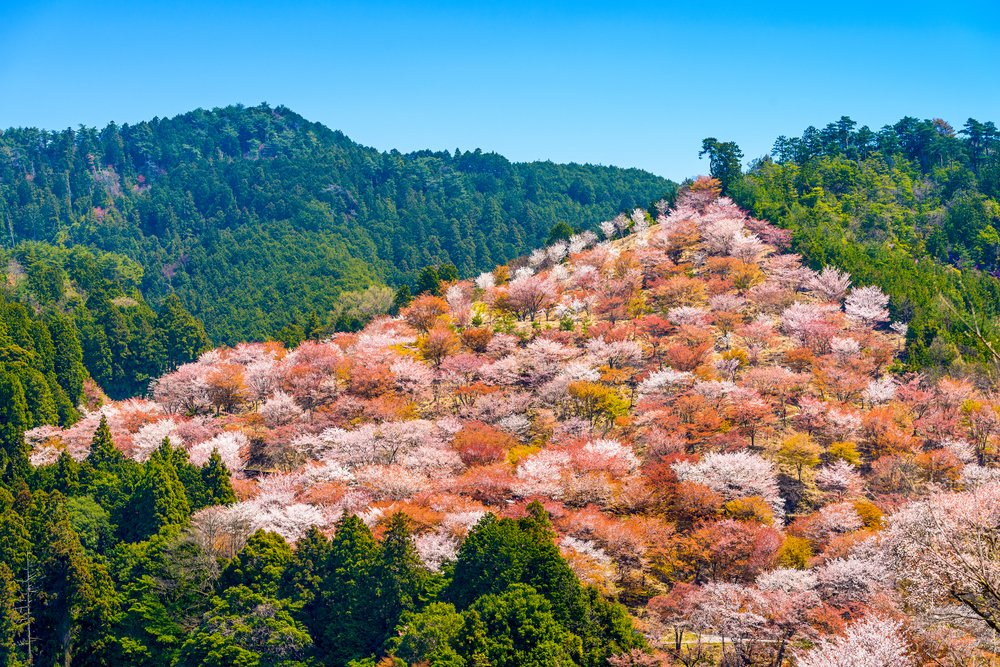
That’s a tricky question to answer.
Unlike the seasons of the year, the dates for the cherry blossom season vary depending on the region.
In previous years the peak season has been from late March to early April.
Generally speaking, they will first appear in southern Japan in Okinawa—where the climate is warmer—before making their way up north to Tokyo and Kyoto. The last area they bloom in is Hokkaido.
Since the sakura in Japan only stay on the trees for around 10 days (2 weeks at the most), it’s common for tourists and locals alike to continually check the cherry blossom forecast as spring approaches.
The Best Places to See the Cherry Blossoms by Region
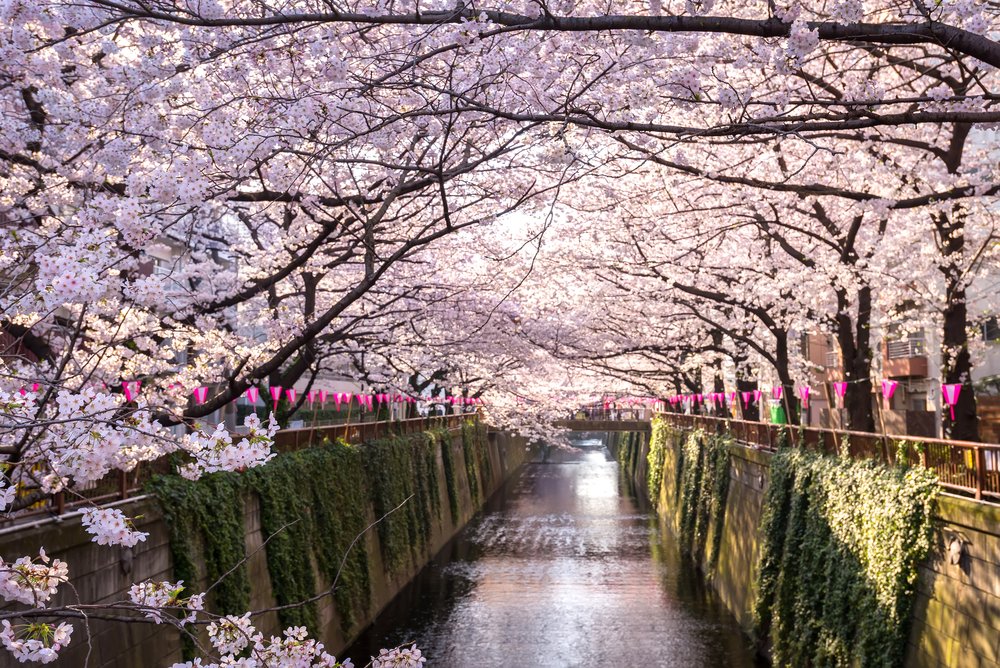
The Kyushu Region
This is one of the southernmost islands in Japan. The region is known for its lush green countryside with waterfalls, natural hot springs and pristine beaches.
Below are the best places in the region to check out the cherry blossoms:
Okinawa
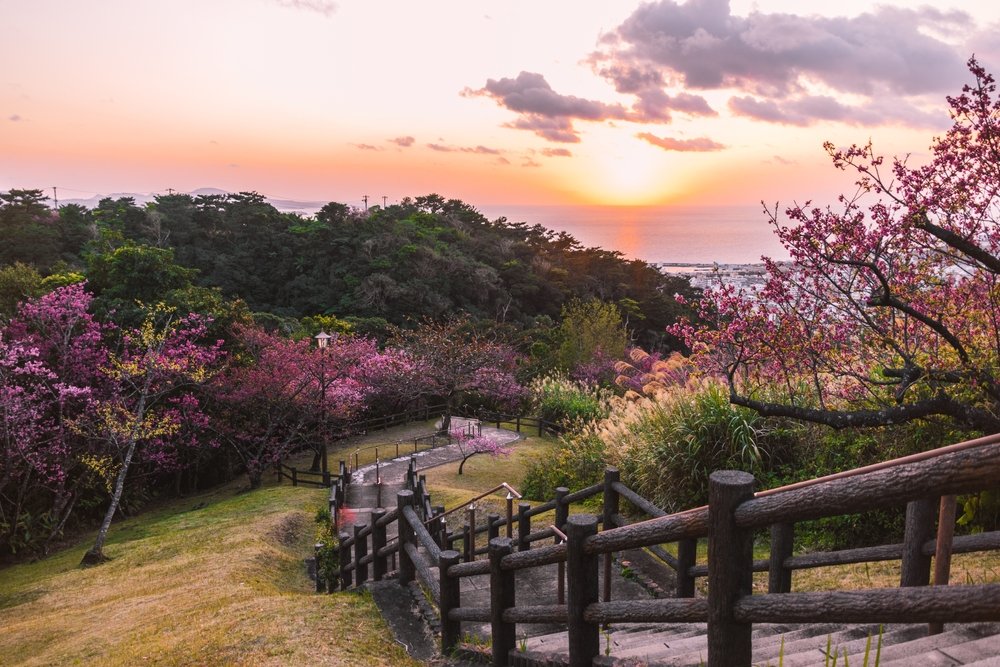
If you are heading to Japan before the peak of the cherry blossom season, come here as the flowers bloom the earliest, normally starting in mid-January.
There are cherry blossom festivals in the area, like the one at Yogi Park called Naha Sakura Festival.
Fun fact—The cherry blossoms that bloom in Okinawa are different from those in mainland Japan. Kanhizakura trees bloom in a downward direction and are deeper shades of pink.
Kagoshima

Due to the warmer climate, the cherry blossom season also starts earlier here—around the middle to end of March.
Fukuoka
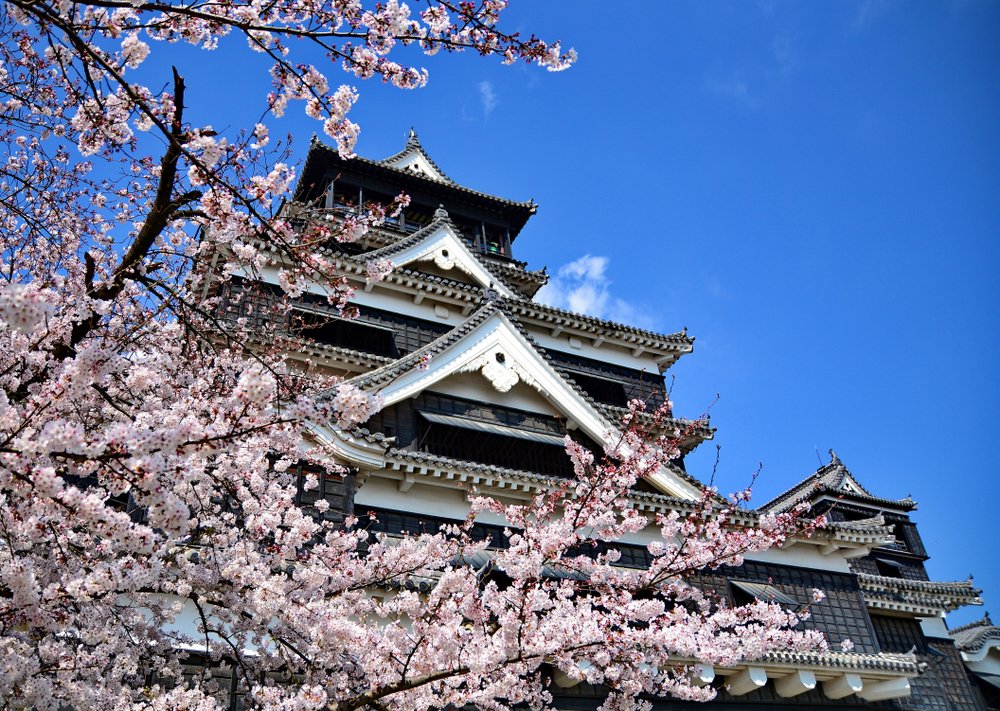
This harbor city in the Kyushu Region is another great place to come during the cherry blossom season. The season runs at a similar time to Kagoshima.
Be sure to head to Maizuru Park, which lies within the premises of Fukuoka Castle. There will be loads of hanami parties, but also check out the observation deck for incredible views of the cherry blossoms.
The Chugoku Region
The Chugoku region consists of the southwest part of Japan’s main island, Honshu. There is a lot of historical significance in the area, as well as natural beauty and some incredible hikes.
Hiroshima

Even if you are coming to Hiroshima to view the cherry blossoms, it’s important to understand the historical significance of this area by visiting the Atomic Bomb Dome and the surrounding memorial park. There are cherry trees all around the park, with locals hosting hanami parties.
History shows that the flowers typically bloom in the last week of March and the first two weeks of April.
The Kansai Region (also known as Kinki)
Consisting of seven prefectures, this region is home to some popular tourist destinations, including Kyoto and Osaka. The area lies in the southern-central part of Japan’s main island.
Kyoto

There are several significant temples and shrines in Kyoto, so it’s no surprise this ancient city may be on your list to visit.
One spot you can’t miss is the Philosopher’s Path which is approximately two kilometers (1.2 miles) in length. The stone path follows a canal lined with flowering trees during the cherry blossom festival.
If you wish to stop by some temples, head to To-ji Temple, Ninna-ji Temple and Yoshimine-dera Temple.
The first is home to Japan’s tallest wooden five-storied pagoda with approximately 200 cherry blossom trees nearby. There is an illumination show which takes place between 5.30–9.30 pm.
What makes Ninna-ji Temple special is the unique variety of late-blooming cherry trees known as Omuto-zakura. Due to its exquisite beauty combined with the five-story pagoda, it is recognized among Japan’s 100 best sakura viewing spots.
Yoshimine-dera Temple is further away in Kyoto’s western mountains, so it won’t be as crowded. With over 100 cherry blossom trees, the backdrop is unmissable!
Pro tip: This region isn’t just incredible for cherry blossoms. If you’re a leaf-peeper, head to Kyoto in autumn when the trees turn from green to gold and red. It’s the most famous city for fall leaf watching.
Hyogo

Besides beautiful sandy beaches and hot springs, an iconic location in Hyogo is Himeji Castle. Built in the 1600s, the views of the six-story wooden structure from afar and close up are majestic. Particularly when over 1,000 cherry trees are blooming.
Pro tip: Don’t forget to leave time for a boat ride on the moat which offers a completely different perspective.
Nara
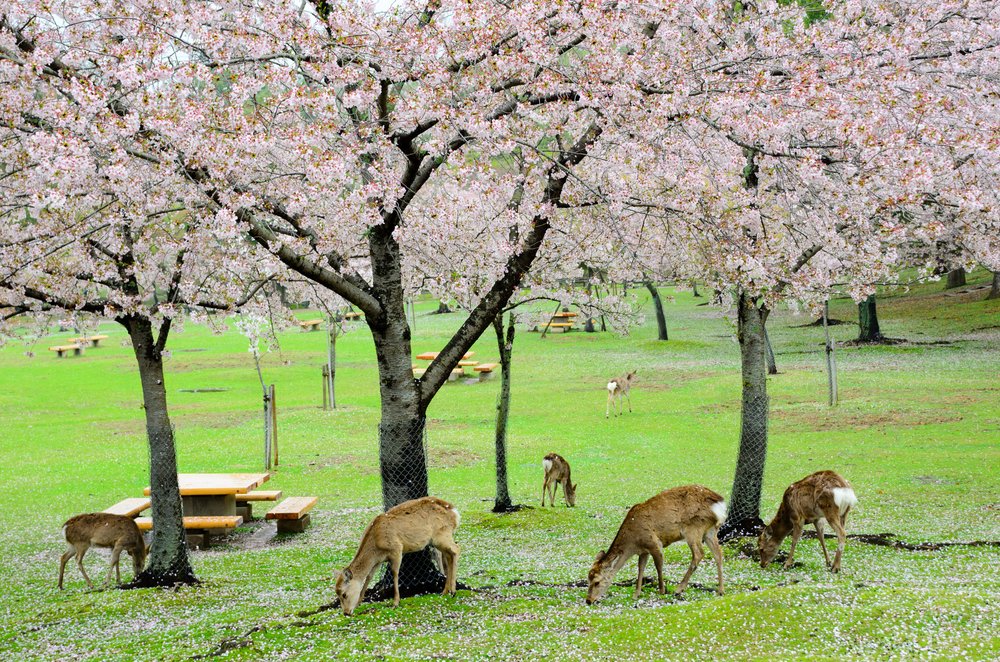
Nara is only 45 minutes from Kyoto by train, so this is an easy day trip.
Even if you are not visiting during cherry blossom season, you must stop at Nara-koen Park, where hundreds of friendly deer roam free. You can buy food and feed them while you are there.
Also, check out all 30,000 cherry blossom trees of different varieties spread across the valley and ridge in Mount Yoshino.
Osaka

Osaka, arguably Japan’s street food capital, is all about trying local snacks, including takoyaki (baked octopus balls) and okonomiyaki (Japanese savory pancakes).
In between eating and drinking, you will want to check out Osaka Castle. The best time to see the cherry blossoms is the last week of March and the first week of April.
For a picturesque setting, head to Kema Sakuranomiya Park to enjoy a picnic while admiring the cherry trees on the riverside.
Pro tip: From Kyoto to Osaka, it is only 14 minutes by train, so combining them as part of your itinerary is excellent.
The Chubu Region
Consisting of nine prefectures, Chubu is in the center of Japan’s main island. Besides being a manufacturing, shipping and entertainment hub, the region is home to many mountainous areas, including the famous Mt. Fuji.
Nagoya

While the dates for the cherry blossoms vary year to year, one of the area’s highlights is Nagoya Castle, where you’ll see over 1,000 cherry blossoms of 10 different varieties. In addition, there is a light show in the evening, as well as local food and drink stalls.
Stretching 2.5 kilometers (1.6 miles), you can’t miss Yamazaki River, one of the premium viewing locations of the cherry blossoms. The bridges that cross the bank offer insane views.
Nagano

When you research Nagano, you will likely come across numerous world-class ski resorts—the region hosted the Winter Olympics back in 1998.
So what’s it like during the cherry blossom season?
Stunning.
One of the most popular places to come is Takato Castle Park, home to 1,500 cherry blossom trees. The tree variety you will spot is known as Takato Kohiganzakura. With smaller petals and a deeper shade of pink, this flower is unique to the area.
Ueda Castle Park is a famous castle built in 1583, and with over 1,000 cherry trees, you must include this on your list of places to visit.
Head to Matsumoto Castle during the evening for a romantic stroll through the gardens. It’s like a fairytale with the trees that line the outer moat all lit up.
Kanazawa
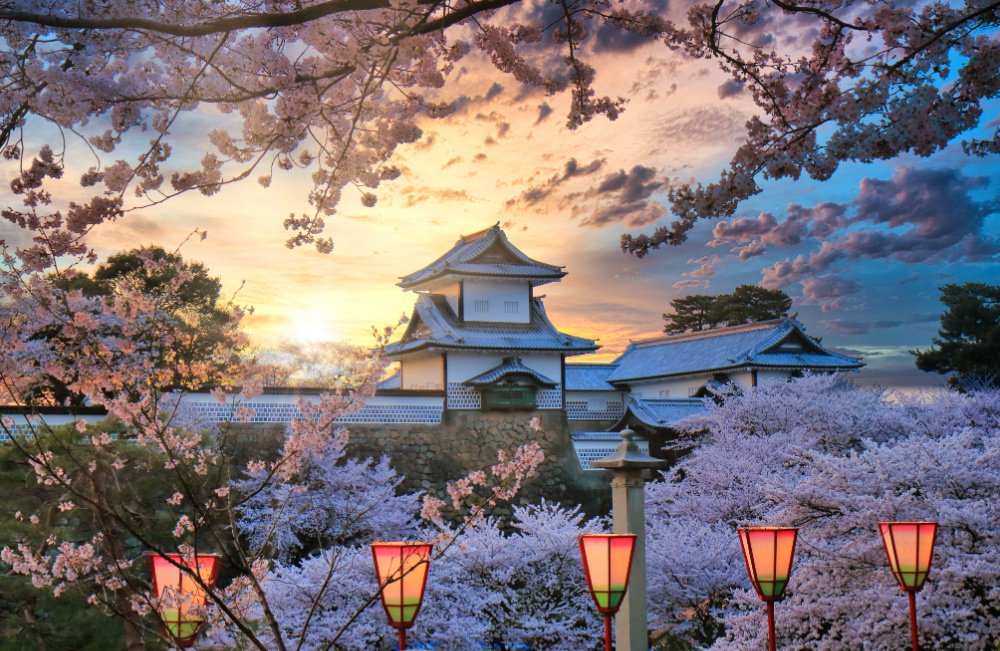
The cherry blossoms usually bloom in the last week of March and the first two weeks of April in Kanazawa.
At Kenrokuen Garden, one of the most famous gardens in Japan, the trees form a tunnel of blossoms.
Be observant, so you don’t miss the 40 varieties in this garden.
The Kanto Region
Kanto is the most populated region in Japan. It’s not surprising, seeing that it encompasses the capital city of Tokyo, with almost 14 million residents. Moreover, it is the political and economic center of the country, located in the eastern part of Japan’s main island.
Tokyo

Of course, Japan’s capital city is a popular spot during the cherry blossom season. The large parks and gardens are perfect places to enjoy picnics and hanami parties. The season usually lasts from late March to early April.
With over 1,000 cherry blossom trees, Ueno Park is one of the most famous spots. There is a variety of museums, a zoo and a beautiful pond to explore on the grounds. In the evening, paper lanterns are lit, illuminating the trees.
Head to Shinjuku Gyoen National Park with its immaculate landscaping. There are about 68 varieties of trees that bloom at different times, making this an ideal place to come to if you are visiting outside the peak season.
Rikugien Gardens has a stunning 70-year-old weeping cherry blossom tree as you enter. As it cascades down, it appears like a waterfall. It’s a great place to walk around at night with all the trees lit up.
If you need some downtime, grab a bite to eat or a drink at one of the cafes and restaurants along the Meguro River. Cherry trees form a pale pink arch over the bank with a number of bridges to cross.
You won’t want to forget your camera.
The Tohoku Region
Located in the North of Japan’s main island, the Tohoku region is known for its mountains, countryside, lakes and hot springs. During the winter, the area is covered in a thick blanket of snow, with some impressive festivals inviting people to the region.
The cherry blossom season usually starts in the middle of April and continues until the beginning of May.
Sendai

With its location up north, the cherry blossoms bloom later than in Tokyo and Kyoto—typically around the middle to late April.
Check out Mikamine Park, located south of central Sendai. With hundreds of trees and vast lawns, it’s a great place to bring food and drinks for a picnic.
The highlight of Tsutsujigaoka Park is the weeping cherry trees planted along the walkways. Many Japanese enjoy viewing parties here, so come along to join in the action.
Pro tip: The air will still be crisp at this time of the year, so bring some layers for the evening.
Fukushima
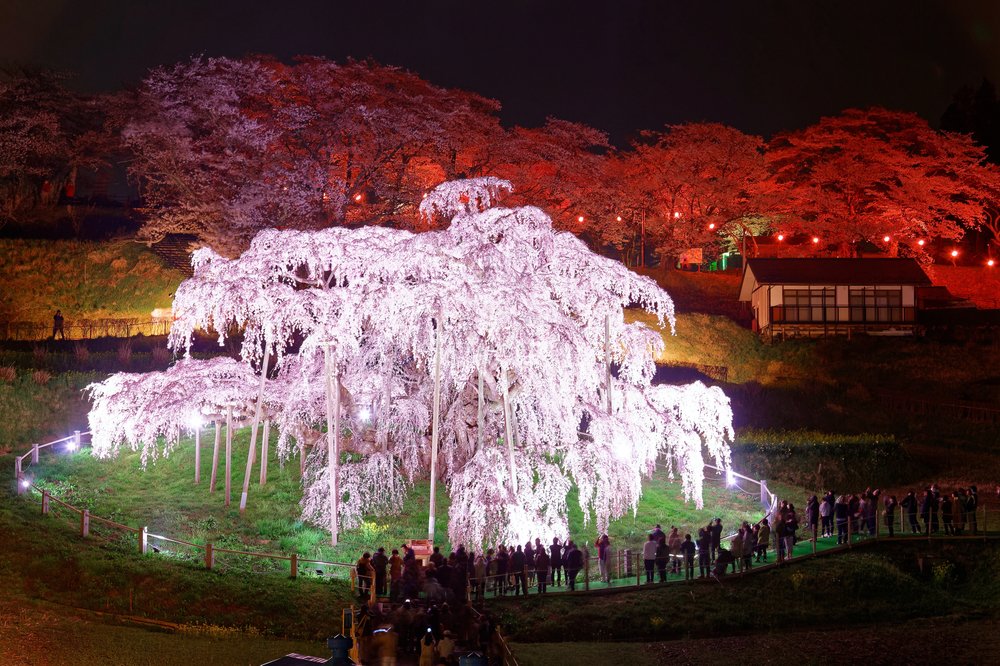
While you can’t play favorites, Fukushima is home to the country’s most beloved cherry blossom tree. The sizeable weeping tree is believed to be over 1,000 years old and is known as Miharu Takizakura. Standing at 12 meters, there is a walking path around it.
Miyagi

The prefecture of Miyagi is recognized primarily for its seafood and agricultural selections. Getting to Miyagi from Fukushima is an easy 15-minute train ride, so it’s possible to visit as a day trip.
When visiting during the cherry blossom season, you will want to head to an area known as Hitome Senbonzakura, along the Shiroishi River. The trees stretch for 8 kilometers (5 miles), so go for a stroll while admiring the snow-capped Zao Mountains in the background.
Aomori
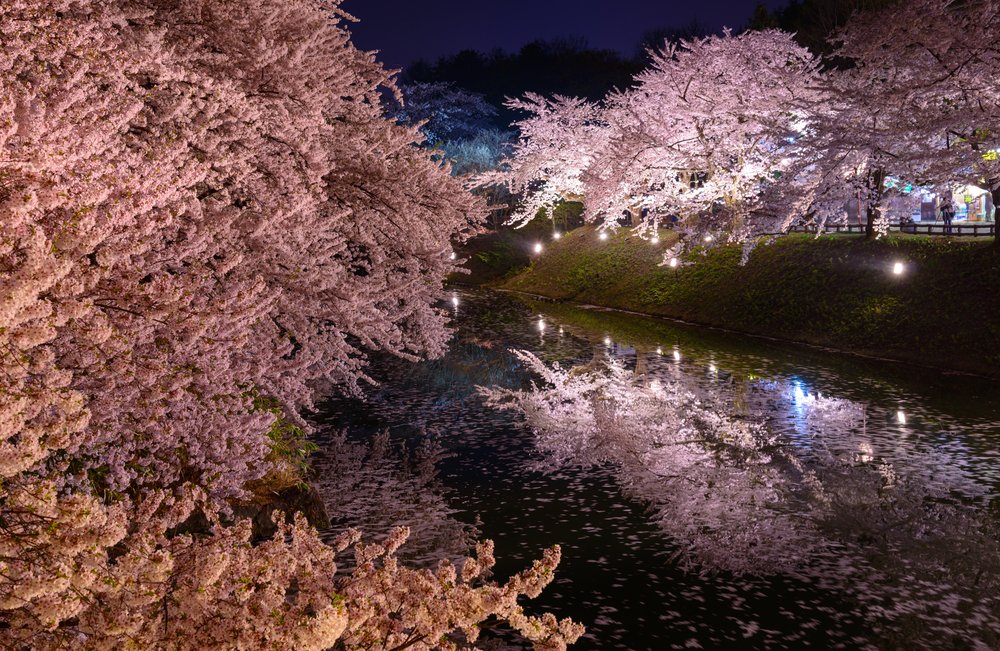
With so many breathtaking choices, it’s hard to choose where to see cherry blossoms. But you won’t be disappointed heading to an area with one of the best cherry blossom viewing spots in Japan. With approximately 2,600 trees, Hirosaki Park is an incredible place to explore.
Check out Mt. Iwaki—home to nearly 6,500 cherry blossom trees. The mountain has been sacred since ancient times.
The Hokkaido Region
Located in the north of Japan, the Hokkaido region is well-known for unspoiled nature, winter festivals, coastal villages and some of the freshest seafood in the country.
This is the last region to experience the cherry blossom season in Japan.
Sapporo

Blooming from late April to early May, this city is the perfect place to come to if you miss the cherry blossoms in other regions. It is quieter and allows you to see a more intimate side of the country.
Take a stroll through Maruyama Park and Hokkaido Shrine. They are next to one another, so you can check out the cherry blossom-lined path leading to the shrine and, afterward, enjoy a picnic in the park.
The most famous park in the city is Odori, and although it’s not one of the popular viewing spots, there are cherry blossoms to be seen.
Why not visit another park while you are at it? Moerenuma Park was designed by the artist Isamu Noguchi and has a fascinating design. Don’t miss the dense grove of cherry blossoms.
Hakodate

A highlight location to come to during the cherry blossom festival is Goryokaku Fort. Head to Goryokaku Tower. You’ll be fascinated by the star-shaped grounds surrounded by moats.
You can travel from Sapporo to Hakodate in 5 hours and 30 minutes by taking the bus.
Furano
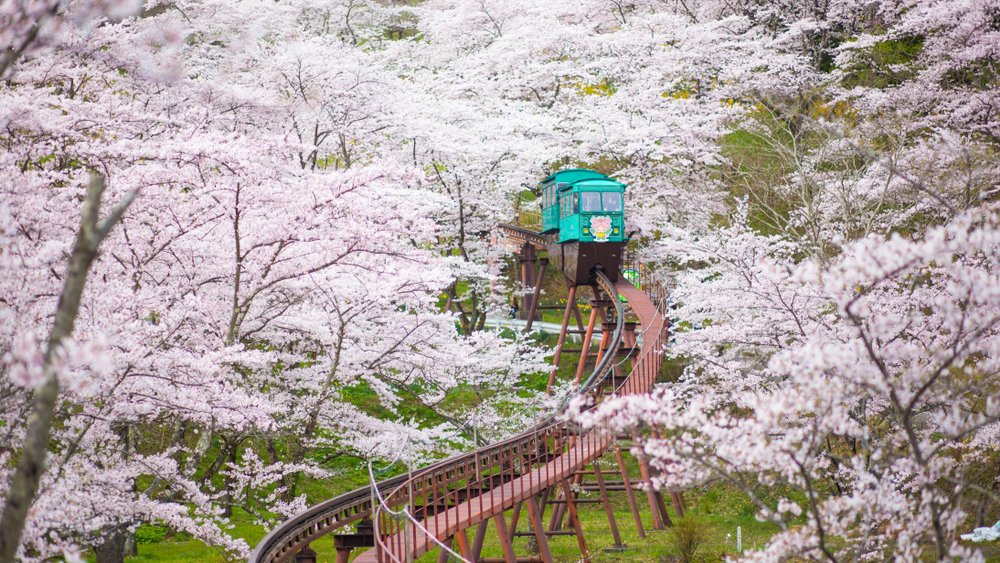
Furano is a large-scale ski resort on Mount Furano-Nishidake, which can be enjoyed well into the spring. It’s a unique experience as you can ski down the mountain while admiring the cherry blossom trees in the village.
Head to the eastern part of Furano to Asahigaoka Park, where over 3,000 cherry blossom trees are located. The entire area looks like a Japanese painting with a field of pink and snow-peaked mountains in the background.
Otaru

For two views in one, visit Mt. Tengu, which overlooks the city and the Sea of Japan. If you stroll at night, you will notice the trees are lit from underneath, creating a theatrical scene.
Pro tip: If you are traveling by train from Minami-Otaru station, check out the cherry blossom trees as they sway when the trains arrive at the platform.
Asahikawa
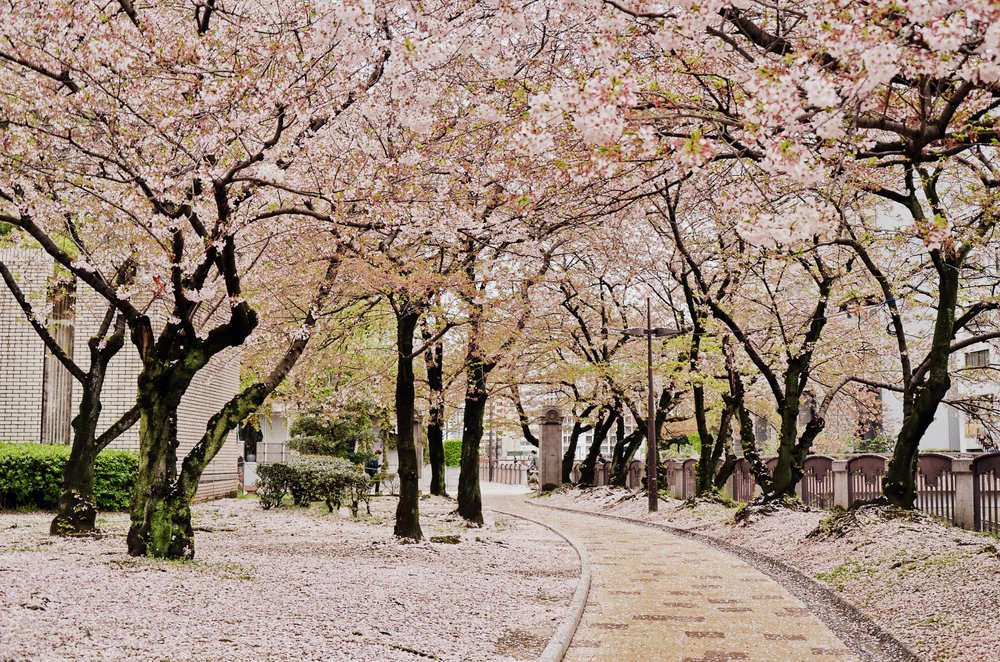
Asahikawa Park is one of the most famous spots in Hokkaido to see cherry blossoms. The number of trees has grown from 1,000 to 3,500, so you can imagine this spot now features beautiful shades of pink throughout.
Weather in Japan in Spring
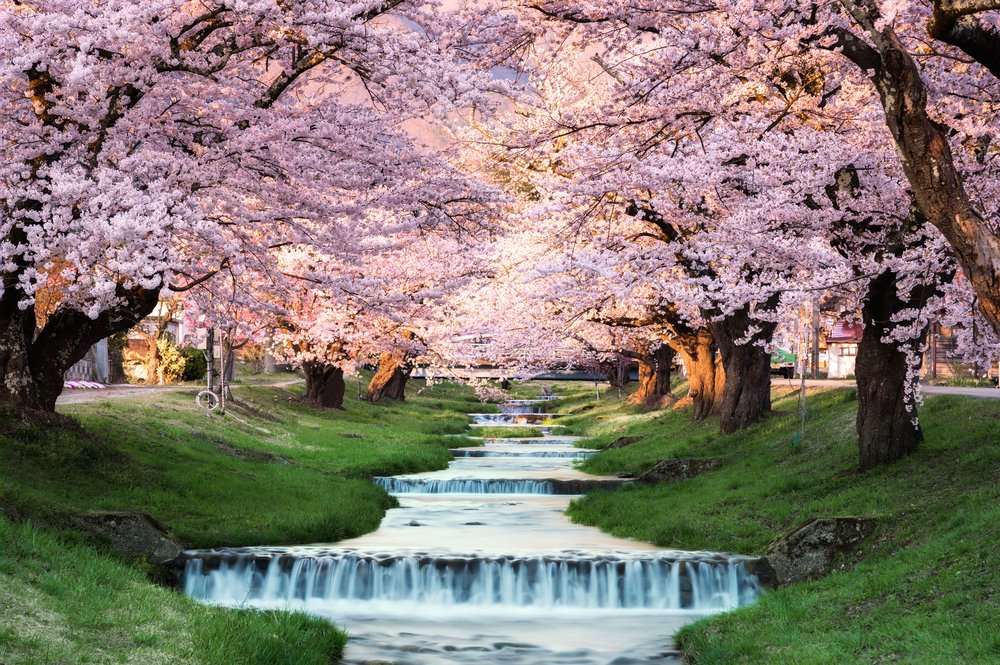
Japanese people associate springtime in Japan with the annual cherry blossom season. As winter comes to an end, trees bloom with gorgeous shades of pink throughout the country.
Spring spans from March to May. The temperatures throughout the regions vary quite dramatically.
For example, the Kyushu region is much hotter in March than Hokkaido. In Kyushu, the temperatures are around 75°F (24°C) during the day and 64°F (18°C) in the evening. In comparison, in Hokkaido, temperatures range from 60°F (16°C) during the day and 28°F (-2°C).
Since you will most likely arrive in Tokyo, let’s look at the weather there in spring.
While March experiences a top temperature of 57°F (14°C), by May, the temperatures increase to a high of 73°F (23°C).
Packing List Essentials for Japan in Spring
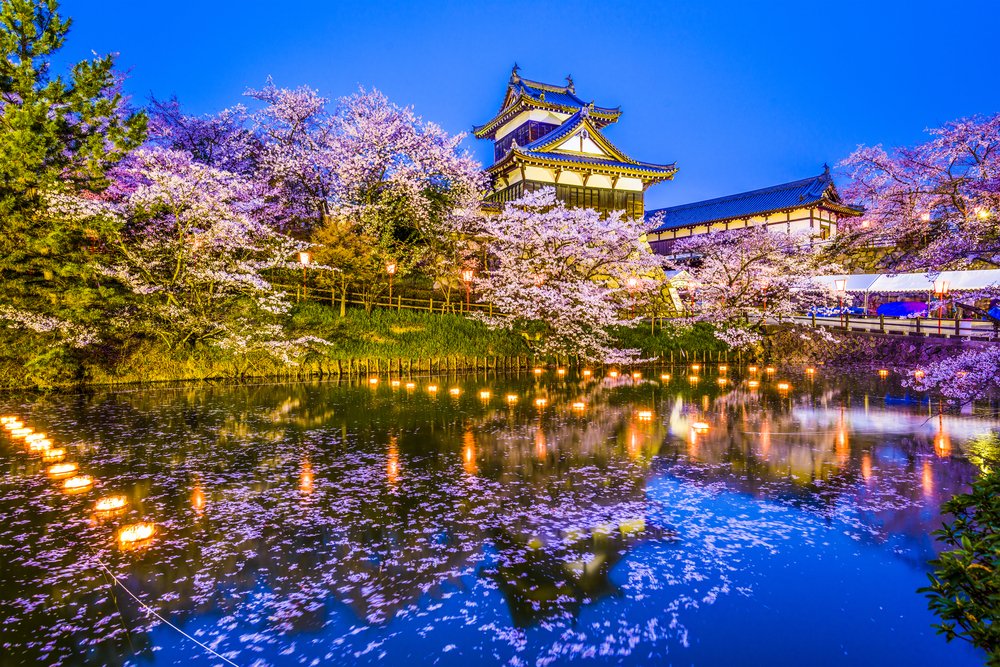
Here comes the hard part. Knowing what to pack can be challenging, especially if you are planning to visit different regions.
In short, it’s all about layers.
Below are a few items that you won’t regret packing:
- Comfy pair of walking shoes – you’ll need these walking through parks and shrines and to/from the train stations.
- Warm jacket or coat – even though Kyushu experiences warmer temperatures than the rest of the country, you will still want to bring a light coat. The further north you go, the thicker the jacket you will need.
- Layering pieces – bring layers such as a t-shirt, jumper or scarf so that you can remove or put on layers as you need, especially if you will be out at night.
- A backpack – carrying your phone, camera and accessories around during the day can get irritating, so the most comfortable option is to bring a backpack.
- Camera or GoPro – this may be a once-in-a-lifetime experience, so of course, you will need to capture the cherry blossoms. Your friends will love seeing the photos that you bring home!
Map of the Best Cherry Blossom Spots
Japan is pretty spread out. Check out our interactive cherry blossom festival map, so you can better plan your trip.
How to get to Japan

With three international airports and a legendary train system, traveling throughout Japan has never been easier.
Narita Airport, which sits outside of Tokyo, is known as the gateway to Japan. The airport also services many domestic flights as well as international flights arriving daily. To get to the city, it’s easy to take an hour express train to Tokyo Station.
Haneda Airport in Tokyo is much closer to the action as it only takes 30 minutes by express train to the city.
Serving the western area of Japan, Kansai International Airport is situated just over an hour from both Osaka and Kyoto.
Once in Japan, the easiest way to get around is by train. There are five different train systems: Shinkansen (the premium service), limited express trains, express trains, rapid trains, and local trains.
For example, you can travel from Tokyo to Kyoto in 2 hours and 15 minutes on the Shinkansen or from Osaka to Hiroshima in 1 hour and 30 minutes.
FAQ
For the most accurate information on the cherry blossom forecast for 2023, follow the data released by the Japan Meteorological Corporation.
Every year is different, but the cherry blossom festival generally starts mid-January in Okinawa and ends in Hokkaido in late April/early May.
With over 1,000 locations across the country, there is not one best spot to go to. It really depends on what week you will visit during the cherry blossom festival.




